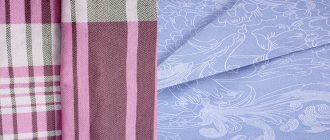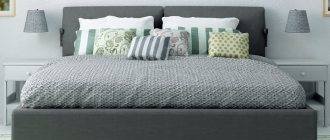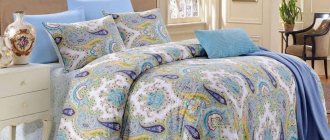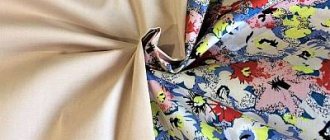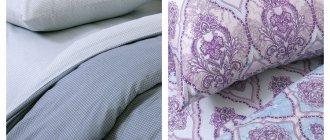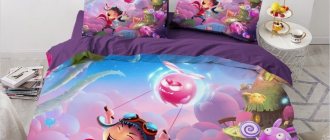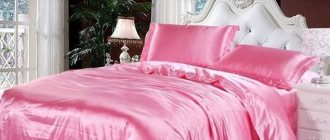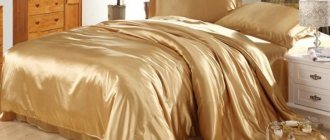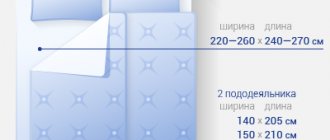History of fabric
In the 14th century, French weavers in the city of Avignon invented the technology for producing soft and high-quality fabric. Initially, the fabric was made from natural silk; clothes were made from it for the Pope and his entourage. Hence the name - poplin , translated from French and Italian meaning “papal”.
“Papal fabric” quickly spread in Europe, but was brought to Russia a little later, in the 18th century. But high society immediately liked it. Over time, cotton began to be added to the material, and then synthetic fibers.
How it is produced
Poplin is made using simple plain weaving: one warp thread alternates with one weft thread in a checkerboard pattern. Threads of different thicknesses are used: the warp threads are thin, and the weft threads are 1.5–2 times thicker and coarser. The density of the warp is greater than that of the weft. A relief pattern in the form of a transverse rib is clearly visible on the fabric. The weaving is frequent, the threads are fastened to each other firmly and firmly. The canvas is double-sided and looks the same on the front and back.
During production, the fabric can be additionally treated with a concentrated alkali solution to prevent fading and give the material a light, noble shine.
Comparison with calico
To be able to distinguish poplin fabric from calico, you need to know the characteristic differences between these fabrics:
- Initially, when weaving poplin fabrics, silk threads were added, which provided additional shine to the finished product. Although today silk can be added exclusively to expensive fabrics, the technique has remained the same, and characteristic scars can be seen on the front surface of the fabrics. But you can see what Casanova satin bed linen might look like here.
- All calico fabrics are less dense and durable than poplin, so they last much less.
- Poplin always has characteristic scars, which are associated with the nature of the weave of the threads, and for calico, the usual method of weaving weft and warp is used. Reliefs are formed through the use of threads of different thicknesses, which is why the so-called scars are noticeable.
- Important differences in density . Products made from bleached calico are clearly visible in the light, while light does not pass through poplin well, which confirms the unusual density of the weave of the threads.
It may also be useful for you to know what sizes exist for a set of baby bedding for a crib.
Application
- Poplin is widely used for sewing high-quality bed linen.
- The material makes comfortable, fashionable and beautiful clothes: dresses, women's blouses, retro-style skirts, men's jackets, shirts, things for little fashionistas.
- Doctors, salespeople, and waiters wear poplin workwear
- The material is suitable for the production of home textiles : tablecloths, curtains, towels.
Composition and properties
Poplin density is approximately 120 g/m². The fabric is thin, but it cannot be torn.
The composition of matter may include fibers of different types.
- Cotton poplin is natural, safe, hypoallergenic, and contains pure cotton of plant origin.
- Semi-silk poplin contains thin threads of natural silk and thick fibers of natural wool, the material is surprisingly delicate, small scars are especially noticeable on the fabric due to the large difference in the thickness of the raw fibers.
- Blended poplin contains cotton in combination with a small amount of synthetic fibers, because of this the properties of synthetic materials are manifested; pellets may form on the surface of this type of fabric, the fabric tends to become electrified, and it allows air to pass through and collects moisture worse than natural matter.
Fabric composition and characteristics
Poplin is also called “papal fabric”. The name arose due to the initial use of the material by French weavers to sew the robe of the Pope. Initially, the fabric was made from silk, then cotton and synthetic fibers began to be added to the weaving. In Russia, the material has been known since the 18th century under the name “European calico.”
If initially, mainly silk fibers were used to create poplin, now preference is given to cotton threads, and silk is added only for dilution. The material often includes synthetic fibers that increase the performance characteristics of the fabric.
Poplin has a lot of advantages:
- High density – 115 g/m2. This allows the material to be durable, soft and pleasant to the body at the same time.
- Breathability. The fabric perfectly allows air and moisture to pass through, thereby allowing the skin to breathe.
- It holds its shape well, so it practically does not wrinkle.
- Undemanding in care. Does not wash out and retains color even with frequent washing.
- Does not conduct static electricity.
- Fully complies with the “price - quality” condition.
Products made from such fabrics are durable and wear-resistant.
Types of fabric
According to dyeing technology, the material is divided into 4 types.
- Bleached - snow-white poplin. To eliminate gray and yellow tones, the woven fabric is treated with a bleaching chemical. Bleached poplin is used for sewing products or can be an intermediate stage in preparation for dyeing fabric.
- Plain dyed - woven and bleached fabric is dyed the same color. Painting is done with dye drums. The whole process takes about 10 hours. Next, the material is washed to remove excess coloring components.
- Multi-colored - for the warp and weft, multi-colored pre-dyed threads are taken, often the result is a fabric with a thread pattern in the form of a cage or strip.
- Printed - poplin with a colorful, clear pattern applied to the base of the finished canvas. The use of high-quality dyes allows us to achieve durable and non-allergenic coloring.
Advantages and disadvantages
Poplin has many advantages:
- soft and comfortable to the touch,
- allows air to pass through and absorbs moisture;
- not electrified;
- capable of thermoregulation: cools in hot weather, keeps warm in cold;
- holds its shape and does not warp after washing;
- does not fade, does not fade, does not form pellets on the surface;
- the natural composition of the fibers does not provoke allergies or skin rashes, the material is safe to use;
- The products do not need to be ironed; if desired, after washing they can be carefully folded and stored in a closet.
No disadvantages Synthetic material has the disadvantages inherent in synthetics: it can become electrified and does not allow air to pass through. Poplin with wool can shrink if not cared for properly.
How to wash and care for poplin items
Since poplin may contain fibers of various origins, always pay attention to the product label. If it includes:
- cotton only - wash the product at temperatures up to 95 degrees;
- synthetics - exposure to high temperatures can lead to shrinkage, so choose a water temperature not exceeding 40 degrees;
- wool or silk - give preference to the delicate mode with a temperature of no more than 30 degrees.
Washing and drying rules:
- choose gentle products suitable for the type of fiber in the composition;
- if the composition includes silk or wool threads, set the minimum spin speed; if cotton threads, set the spin speed to medium;
- turn the product inside out before washing;
- use bleaches and stain removers with caution, only on white fabrics;
- Dry items immediately after washing in natural conditions, away from sunlight and artificial heat.
There is no need to iron the material, just gently straighten the product before drying.
Care instructions
The fabric is unpretentious:
- washing is possible at temperatures up to 60 degrees, fabric can be washed well even at 40 degrees;
- soiled cotton poplin can be boiled and washed at 90 degrees;
- You can use regular washing powder, no special products are required;
- Machine spinning at maximum speed and machine drying are allowed;
- It is not necessary to iron poplin products; they take their shape on their own after washing.
Depending on the fabric composition, the product may require slightly different care conditions. All the necessary information is on the tag, read it carefully before washing for the first time and strictly follow the instructions. The service life of poplin items will increase significantly.
Detergents
Poplin can be washed effectively using washing powders. It is important that their composition does not contain abrasive particles or aggressive additives. It is not recommended to use them often.
For the durability of comfortable poplin products, preference should be given to washing gel varieties. To preserve rich colors, I select a gel recommended by the manufacturer for colored products.
The popularity of various brands of gels aimed at washing is explained by their high degree of solubility and good performance. These compositions do not cause irritation to the skin because they are easy to rinse.
ARTICLE FOR YOU
How to wash pique items: in the washing machine and by hand
Popular brands recommended for careful care of textiles:
- Persil Universal Gel is valued for its effective stain removal and color retention. Due to the presence of the cellulose enzyme in the structural formula, the gel provides the surfaces of products with the necessary smoothness.
- Beads Gel shows high efficiency when washing poplin items without causing color distortion or fading. It washes off well and prevents yellowing of the fabric.
- Lion TOP-strength gel product is perfect for cotton poplin. When machine washed, it retains its shape, does not deform the fibers, retains color saturation, and imparts a subtle pleasant smell.
Cotico Color washing gel
An important criterion for selecting a specific brand of gel is the composition of the fibers from which the fabric is woven.
Poplin bed linen
Poplin sets are soft, thin, with a matte surface, strong and durable. The linen can withstand repeated washing without losing color or shape; the average lifespan of the set is 5 years. Poplin linen is used for home use, as well as in luxury hotels and holiday homes.
Poplin of different compositions is used to make bed linen. High-quality sets are sewn from pure cotton, luxury sets are made from a combination of natural silk and wool.
How to choose a poplin set
Poplin bed linen is extremely high quality and practical. The main thing when choosing is to recognize and not buy a fake.
- When choosing a bedding set, pay attention to the quality of tailoring. If you see protruding threads, uneven or unfinished seams, refuse to purchase. This kit does not meet the standard.
- Look at the quality and density of the fabric. With a density of less than 120 g/m² and a large percentage of synthetics in the composition, the fabric will be of mediocre quality.
- Give preference to reputable manufacturers.
- To recognize natural poplin, scrunch the fabric; it should smooth out and take its original shape.
- It is recommended to check the color fastness if possible. Spray the fabric with water; the paint should not spread or remain on your fingers.
- The design on the set must be clear and bright.
- Select the appearance of the set based on your taste, taking into account the features of the bedroom interior. A wide range of products will give you the opportunity to choose.
Pros and cons of the material
An unusual method of weaving fabric was invented in the French city of Avignon, and at first the fabric was intended exclusively for sewing papal vestments, which is why it was called poplin.
Manufacturers mainly make poplin fabrics from cotton fibers, but sometimes silk or synthetic threads can be added to it. But the highest quality fabric is made in Chinese, Indian or Turkish weaving factories, since cotton is grown there in abundance. But what family bedding sets with two duvet covers look like and how practical they are can be seen here.
Poplin bed linen has become widespread because it has a number of undeniable advantages:
- High sleeping comfort . The fabric is distinguished by its impeccably smooth structure, while remaining unusually dense. These qualities allow the linen not to wrinkle during sleep, and by the morning it will look as neat as before going to bed.
- High rates of long, impeccable service . Poplin bedding can withstand up to 200 aggressive washes without changing the quality of the fabric, and is also resistant to wear.
- The fabric has high hygroscopicity and breathability - these properties help maintain natural body temperature throughout the night - in summer it will save you from heat, and in winter from cold.
- No signs of allergic reactions on the skin of a sleeping person. This indicator has been repeatedly confirmed in practice.
- Easy to care for. All bedding practically does not wrinkle even during restless sleep, is easy to wash and dry quickly.
- Great appearance . The fabric has a slight shine, so it looks very attractive.
But what microfiber bed linen looks like and what reviews there are can be seen here.
In the video - poplin bed linen:
But does the fabric have any disadvantages?
Yes, this can be detected if you buy a fake; high-quality and branded fabric has virtually no flaws, except for the natural wear and tear of bed linen over time.
A low-quality canvas will have the following characteristics:
- Persistent chemical smell of dyes that quickly fade from aggressive washing.
- After the first immersion in water, the laundry will shrink and significantly decrease in its original size.
- Cutting will be overshadowed by complications, since the obligatory scars (characterizing poplin) will fray, which will cause inconvenience in sewing linen.
However, high-quality poplin fabric does not have all these characteristics and is excellent for making bedding.
It will also be useful for you to know what sizes of bedding for newborns in a crib exist.
Customer Reviews
Poplin has only positive reviews. It is easy to cut, easy to sew, easy to use. The variety of fabric colors makes your eyes wide open. Poplin products do not wear down, they are strong, durable, and after several years of use and many washes they continue to look like new.
Despite changes in composition and new production methods, poplin has retained all the quality characteristics that made it popular at the very beginning. The material is actively in demand, bed linen made from it will add coziness to the interior of the bedroom, and clothes made from poplin will help in creating a fashionable look.
Drying
It is not recommended to dry poplin in the automatic mode found in the washing machine.
The wrung-out items, rinsed well and carefully without intense twisting, are hung on strings. Dry in the fresh air, providing protection from the burning sun.
ARTICLE FOR YOU
How to wash nylon clothes: in the washing machine and by hand
How to dry poplin items after washing
Video: review of poplin bed linen
This video provides a brief overview of bed linen made of poplin fabric with floral patterns.
See similar articles
- Staple - lightweight breathable fabric for summer clothing
- Choosing furniture fabric for cat and dog owners
- 4 main types of fabrics, their properties and purpose
- Felt - wool fabric for needlework and hats
- Kulirka - thin cotton fabric for children's clothing
- Footer - soft cotton fabric for children's clothing
If you liked the article, share it with your friends!
